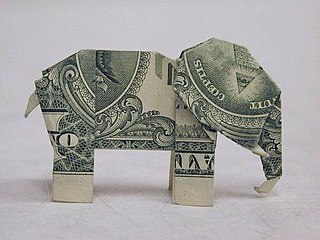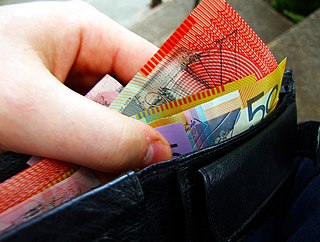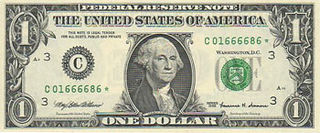 W
WA banknote—also called a bill, paper money, or simply a note—is a type of negotiable promissory note, made by a bank or other licensed authority, payable to the bearer on demand. Banknotes were originally issued by commercial banks, which were legally required to redeem the notes for legal tender when presented to the chief cashier of the originating bank. These commercial banknotes only traded at face value in the market served by the issuing bank. Commercial banknotes have primarily been replaced by national banknotes issued by central banks or monetary authorities.
 W
WA banknote counter or bill counter is a device designed primarily to accurately count a quantity of banknotes. Additionally, a banknote counter may sort banknotes into batches and check for damaged or counterfeit notes.
 W
WColnect Collectors Club Community is a website containing wiki-like collectables catalogs. It allows collectors to manage their personal collection using these catalogs and automatically match their swap/wish-lists with those of other collectors. Colnect provides a marketplace dedicated to buying and selling collectibles. Colnect's phone cards catalog is the biggest in the world.
 W
WA currency strap, currency band or bill strap is a simple paper device designed to hold a specific denomination and number of banknotes. It can also refer to the bundle itself.
 W
WThe EURion constellation is a pattern of symbols incorporated into a number of secure documents such as banknotes and ownership title certificates designs worldwide since about 1996. It is added to help imaging software detect the presence of such a document in a digital image. Such software can then block the user from reproducing banknotes to prevent counterfeiting using colour photocopiers. According to research from 2004, the EURion constellation is used for colour photocopiers but probably not used in computer software. It has been reported that Adobe Photoshop will not allow editing of an image of a banknote, but in some versions this is believed to be due to a different, unknown digital watermark rather than the EURion constellation.
 W
WFireproof banknote is a demonstration of putting a banknote, previously soaked in 50% (v/v) alcohol fuel solution, to a flame. The fire is lit and later extinguished by itself without the banknote being burnt. This demonstration can be used to teach about the fire triangle and classes of fire.
 W
WA hybrid paper-polymer banknote or Composite Substrate is a banknote made from a mixture of paper and polymer substance.
 W
WThe Louisenthal Paper Mill or Papierfabrik Louisenthal in regional language, as a manufacturer of banknotes and security paper. Founded in 1878, the company has been a subsidiary of Giesecke + Devrient since 1964. The mill is best known as a manufacturer of banknotes.
 W
WMoneygami is the shaping of paper currency, such as Indian rupees or United States dollars, into pieces of art. The word is a portmanteau of money and origami.
 W
WNotaphily is the study and collection of paper currency, and banknotes. A notaphilist is a collector of banknotes or paper money, particularly as a hobby.
 W
WNotaphily is the study and collection of paper currency, and banknotes. A notaphilist is a collector of banknotes or paper money, particularly as a hobby.
 W
WPolymer banknotes are banknotes made from a synthetic polymer such as biaxially oriented polypropylene (BOPP). Such notes incorporate many security features not available in paper banknotes, including the use of metameric inks. Polymer banknotes last significantly longer than paper notes, causing a decrease in environmental impact and a reduced cost of production and replacement. Modern polymer banknotes were first developed by the Reserve Bank of Australia (RBA), Commonwealth Scientific and Industrial Research Organisation (CSIRO) and The University of Melbourne. They were first issued as currency in Australia during 1988 ; by 1996, the Australian dollar was switched completely to polymer banknotes. Romania was the first country in Europe to issue a plastic note in 1999 and became the third country after Australia and New Zealand to fully convert to polymer by 2003.
 W
WA replacement banknote, commonly referred to as a star note, is a banknote that is printed to replace a faulty one and is used as a control mechanism for governments or monetary authorities to know the exact number of banknotes being printed. Also, since no two serial numbers can be the same, the bill is simply reprinted with a symbol in the serial number, identifying it as a replacement for an error note. Replacement bills have different symbols to mark the error around the world, although the most popular examples are "star notes".
 W
WA security thread is a security feature of many banknotes to protect against counterfeiting, consisting of a thin ribbon that is threaded through the note's paper.
 W
WA specimen banknote is printed generally in very limited quantities for distribution to central banks to aid in the recognition of banknotes from a country other than their own. In some cases, specimen banknotes are printed in less limited quantities distributed to commercial banks, or even to commercial enterprises and the public at large in order to familiarize users about new designs. In addition, specimen banknotes are sold in some countries to collectors. They have also been distributed by banknote printers as examples of their craftsmanship. Occasionally, specimen banknotes are distributed as gifts to dignitaries or to employees of central banks, often in special presentation albums.
 W
WUncut currency sheets are common numismatics collector's items. They are often sold as souvenirs by issuers. After cutting, usually the banknotes can be used as legal tender; however, the cost to purchase uncut currency sheets is typically higher than the aggregate face value of the cut notes.
 W
WA used note is a banknote that has been in circulation. Blackmailers and people demanding ransoms are often heard in movies to ask for a sum of money "in used notes." Used banknotes are preferred by criminals because they are more difficult to trace. Blocks of new banknotes will be in sequentially numbered order.
 W
WA watermark is an identifying image or pattern in paper that appears as various shades of lightness/darkness when viewed by transmitted light, caused by thickness or density variations in the paper. Watermarks have been used on postage stamps, currency, and other government documents to discourage counterfeiting. There are two main ways of producing watermarks in paper; the dandy roll process, and the more complex cylinder mould process.